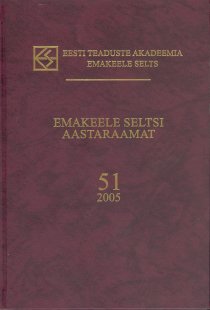Paul Ariste ja Vaipoole vadjalased
Paul Ariste and the Votes of Vaipoole
Author(s): Heinike HeinsooSubject(s): Language and Literature Studies
Published by: Teaduste Akadeemia Kirjastus
Keywords: sociolinguistics; folklore and linguistics; Votic
Summary/Abstract: The dialects of the Votic language are traditionally divided into West-Votic, East-Votic, Kukkusi and Kreevin dialects. The Western dialects are divided into mätši, orko and Vaipoole dialects. In the year 1848 the Votic population could be divided according to the villages as follows: in the villages West of Kattila parish 162 Votes (9%), in the orko group villages 476 (27%), and in the mätši group of villages 1152 (64%). At the time of Köppen there lived 632 Votes in Vaipoole (over 10% of all the Votes). Among the Mätši group of villages the biggest was Kattila village and from there are the first notations of large findings of the Votic language. The Jõgõperä dialect was quite thoroughly studied by O. A. F. Mustonen in his 1883 research report in the journal Virittäjä (issue I, Muistoonpanoja Vatjan kielestä). For a long time the lexicon by Dmitri Tsvetkov Vatjan kielen Joenperän murteen sanasto ‘A Dictionary of the Jõgõperä Dialect of the Votic Language’ existed only in handwritten form, and it was published by Johanna Laakso in 1995. The first individual contact with the Votic language by Paul Ariste comes from the area of the Vaipoole dialect. In 1923 Ariste met Darja Lehti from Jõgõperä during museum festivities in Tallinn. Darja Lehti lived at Vanaküla in Estonia, and Ariste visited her repeatedly in the1937–1939. In 1942 Paul Ariste visited Vadjamaa for the first time. He participated in an excursion organized by the Estonian National Museum. He did not visit the Votes of Vaipoole then. In 1947 at Kukkusi he taped songs by Matjo Gerassimova who was from Jõgõperä. He was able to visit Vaipoole on July 8, 1957. In 1960 Ariste characterized the Votic language of Vaipoole as a mixed language with a strong influence of the Izhorian language. Since the end of 1960 Vaipoole became the main locality for collecting the Votic language. In 1971 he wrote in his diary: I had biased information from Jõgõperä. Supposedly in the village there were not any Votes who knew about folklore, but actually there are several. The 23rd and the last fascicle of the journal Votic Ethnology contains handwritten Cyrillic annotations made in 1988 by Niina Lenivenko: words and short texts. Ariste’s acquaintance with the Votic language began with the Votes of Jõgõperä, and the last contacts were also from there. There were still about 60 Votic speakers at Vaipoole in the summer of 1995. Now there are not more than 10–15. The Votes of Vaipoole have retained their own identity. On the initiative of some activists, the birthday of Luuditsa village has been celebrated since 2000 (in 2000 they marked the 500th anniversary). The Votic flag and the coat of arms have been designed, and the Votic anthem has been composed. A spelling book of the Votic language is being written. The Votic language is facing extinction, but maybe the changing political situation will enable us to preserve the memory and cultural heritage and to honour the past of a very small people.
Journal: Emakeele Seltsi aastaraamat
- Issue Year: 2005
- Issue No: 51
- Page Range: 222-238
- Page Count: 16
- Language: Estonian

